Dinámicas y volatilidades de los rendimientos cambiarios asiáticos, 2020-2024
DOI:
https://doi.org/10.53897/RevChinaGR.2024.04.03Palabras clave:
Rendimientos Cambiarios, Asia, Modelos ARCH/GARCH, Bondad de ajuste, COVID-19Resumen
Se estudiaron las dinámicas y volatilidades de seis series de
rendimientos cambiarios asiáticos durante y después de la pandemia de COVID-19. El estudio emplea siete modelos ARCH/GARCH, diversos supuestos estadísticos y tres criterios de bondad de ajuste. Los hallazgos indican que los modelos más adecuados para describir las series de rendimientos cambiarios, son: 1) el FIEGARCH(1,1,1) para los rendimientos de China, Indonesia y Japón; 2) el FIGARCH(1,1) para Malasia; 3) el GARCH(1,1) para Hong Kong; y 4) el PARCH(1,1,1) para Taiwán. Las seis series de tipos de cambio utilizadas incluyen datos diarios desde el 2 de enero de 2020 hasta el 15 de febrero de 2024.
Descargas
Métricas
Citas
Abbas, M., Nisa, Z. U., & Abbas, U. (2023). Exchange rate volatility in response to COVID-19 in SAARC countries. SAR Journal of Medical Case Reports, 4(4), 36-45. https://doi.org/10.36346/sarjmcr.2023.v04i04.001
Adiyat, M.R., & Danarsari, D.N. (2022). The COVID-19 information impact on movement and volatility of ASEAN-5 currency. Jurnal Bisnis dan Manajemen, 23(1), 16-29. https://doi.org/10.24198/jbm.v23i1.903
Baillie, R.T., Bollerslev, T., & Mikkelsen, H.O. (1996). Fractionally integrated generalized autoregressive conditional heteroskedasticity. Journal of Econometrics, 74(1), 3-30. https://doi.org/10.1016/S0304-4076(95)01749-6
Bollerslev, T. (1986). Generalized autoregressive conditional heteroskedasticity. Journal of Econometrics, 31(3), 307-327. https://doi.org/10.1016/0304-4076(86)90063-1
Bollerslev, T. (2010). Glossary to ARCH (GARCH). En T. Bollerslev, J.R. Russell & M. W. Watson (Eds.), Volatility and Time Series Econometrics: Essays in Honor of Robert F. Engle (pp. 137-163). Oxford University Press.
Bollerslev, T., & Mikkelsen, H.O. (1996). Modeling and pricing long memory in stock market volatility. Journal of Econometrics, 73(1), 151-184. https://doi.org/10.1016/0304-4076(95)01736-4
Burnham, K.P., & Anderson, D.R. (2002). Model Selection and Multimodel Inference: A Practical Information-Theoretic Approach (Segunda edición). Springer.
Cai, Z., Chen, L., & Fang, Y. (2012). A new forecasting model for USD/CNY exchange rate. Studies in Nonlinear Dynamics and Econometrics, 16(3), Artículo 4. https://doi.org/10.1515/1558-3708.1878
Calvo, G.A., & Reinhart, C.M. (2002). Fear of floating. The Quarterly Journal of Economics, 117(2), 379-408. https://doi.org/10.1162/003355302753650274
Diallo, I.A. (2015). Exchange rate volatility and investment: A panel data cointegration approach. Expert Journal of Economics, 3(2), 127-135. https://economics.expertjournals.com/ark:/16759/EJE_322015.pdf#page=41
Ding, Z., Granger, C.W., & Engle, R.F. (1993). A long memory property of stock market returns and a new model. Journal of Empirical Finance, 1(1), 83-106. https://doi.org/10.1016/0927-5398(93)90006-D
Dominguez, K.M., & Tesar, L.L. (2006). Exchange rate exposure. Journal of International Economics, 68(1), 188-218. https://doi.org/10.1016/j.jinteco.2005.01.002
Eichengreen, B., & Hausmann, R. (1999). Exchange Rates and Financial Fragility (Documento de Trabajo, Working Paper W7418). National Bureau of Economic Research, NBER. https://www.nber.org/papers/w7418
Engle, R.F. (1982). Autoregressive conditional heteroscedasticity with estimates of the variance of United Kingdom inflation. Econometrica: Journal of the Econometric Society, 50(4), 987-1007. https://doi.org/10.2307/1912773
Engle, R.F., & Lee, G.G.J. (1999). A long-run and short-run component model of stock return volatility. En R.F. Engle & H. White (Eds.), Cointegration, Causality, and Forecasting: A Festschrift in Honor of Clive W.J. Granger (pp. 475-497). Oxford University Press.
Franco, C. & Zakoian, JM. (2019). GARCH Models. Structural Models, Statistical Inference and Financial Applications (2nd ed). Wiley.
Gujarati, D.N., Porter, D.C. & Pal, M. (2021). Basic Econometrics (6th ed). McGraw-Hill.
Hung, N.T., Nguyen, L.T.M., & Vo, X.V. (2022). Exchange rate volatility connectedness during outbreak: DECO-GARCH and Transfer Entropy approaches. Journal of International Financial Markets, Institutions and Money, 81, 101628. https://doi.org/10.1016/j.intfin.2022.101628
Jamal, A., & Bhat, M.A. (2022). COVID-19 pandemic and the exchange rate movements: Evidence from six major COVID-19 hot spots. Future Business Journal, 8(1), 17. (2022). https://doi.org/10.1186/s43093-022-00126-8
Jarque, C.M., & Bera, A.K. (1987). A test for normality of observations and regression residuals. International Statistical Review/Revue Internationale de Statistique, 55(2), 163-172. https://doi.org/10.2307/1403192
Karim, R. (2024). Impact of COVID-19 on Exchange Rate Volatility of Bangladesh: Evidence through GARCH Model (Preimpreso, ArXiv:2403.02560v1 [econ.GN]). ArXiv. https://doi.org/10.48550/arXiv.2403.02560
Kinkyo, T. (2022). The intermediating role of the Chinese renminbi in Asian currency markets: Evidence from partial wavelet coherence. The North American Journal of Economics and Finance, 59, Article 101598. https://doi.org/10.1016/j.najef.2021.101598
Krugman, P. R. (2009). The Return of Depression Economics and the Crisis of 2008. WW Norton & Company.
Kusumahadi, T. A., & Permana, F. C. (2021). Impact of COVID-19 on global stock market volatility. Journal of Economic Integration, 36(1), 20-45. https://www.jstor.org/stable/26985574
Kwiatkowski, D., Phillips, P. C., Schmidt, P., & Shin, Y. (1992). Testing the null hypothesis of stationarity against the alternative of a unit root: How sure are we that economic time series have a unit root?. Journal of Econometrics, 54(1-3), 159-178. https://doi.org/10.1016/0304-4076(92)90104-Y
Nelson, D.B. (1991). Conditional heteroskedasticity in asset returns: A new approach. Econometrica: Journal of the Econometric Society, 59(2), 347-370. https://doi.org/10.2307/2938260
Pino, G., Tas, D., & Sharma, S. C. (2016). An investigation of the effects of exchange rate volatility on exports in East Asia. Applied Economics, 48(26), 2397-2411. http://dx.doi.org/10.1080/00036846.2015.1122730
Rahman, N., & Parvez, M.A.A. (2022). Exploring the Impact of COVID-19 on Exchange Rate Volatility: Evidence from South Asia (Documento de Trabajo, Paper 4037809). Social Science Research Network, SSRN. http://dx.doi.org/10.2139/ssrn.4037809
Rai, K., & Garg, B. (2022). Dynamic correlations and volatility spillovers between stock price and exchange rate in BRIICS economies: Evidence from the COVID-19 outbreak period. Applied Economics Letters, 29(8), 738-745. https://doi.org/10.1080/13504851.2021.1884835
Ruiz Porras, A., & Fregoso Becerra, L.E. (2016). Modelación de los rendimientos cambiarios de Asia y Latinoamérica: Un análisis basado en los modelos GARCH, TGARCH y EGARCH. Revista Chilena de Economía y Sociedad, 10(2), 62-75. https://rches.utem.cl/?p=651
Ruiz Porras, A., & Hernández Rodríguez, C. (2023). The East-Asian stock markets during the COVID-19 pandemic. China Global Review, 1(1), Articulo 4. https://revistasacademicas.ucol.mx/index.php/China/issue/view/100porras
Sethi, M., Dash, S.R., Swain, R.K., & Das, S. (2021). Economic consequences of COVID-19 pandemic: An analysis of exchange rate behaviour. Organizations and Markets in Emerging Economies, 12(2), 258-284. https://www.redalyc.org/journal/6923/692372872001/692372872001.pdf
Wilson, P., & Ng, H.S.R. (2009). Managing exchange rate volatility: A comparative counterfactual analysis of Singapore, 1994–2003. The Singapore Economic Review, 54(04), 543-568. https://doi.org/10.1142/S0217590809003525
Xu, Y., & Lien, D. (2020). Dynamic exchange rate dependences: The effect of the U.S.-China trade war. Journal of International Financial Markets, Institutions and Money, 68, Article 101238. https://doi.org/10.1016/j.intfin.2020.101238
Zakoian, J. M. (1994). Threshold heteroskedastic models. Journal of Economic Dynamics and Control, 18(5), 931-955. https://doi.org/10.1016/0165-1889(94)90039-6
Descargas
Publicado
Cómo citar
Número
Sección
Licencia
Derechos de autor 2024 Universidad de Colima

Esta obra está bajo una licencia internacional Creative Commons Atribución-NoComercial-CompartirIgual 4.0.
China Global Review permite compartir, copiar y redistribuir el material en cualquier medio o formato; adaptar, remezclar, transformar y construir sobre el material, dando crédito a la obra de manera adecuada y proporcionando un enlace a la licencia, indicando si se han realizado cambios.










